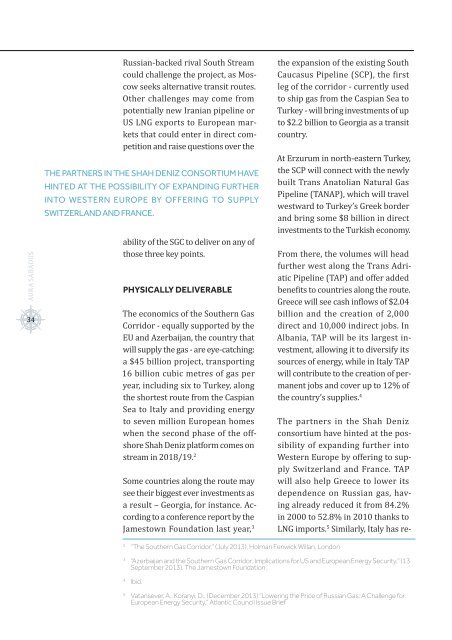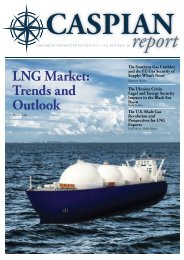Caspian Report - Issue: 07 - Spring 2014
Create successful ePaper yourself
Turn your PDF publications into a flip-book with our unique Google optimized e-Paper software.
Aura Sabadus<br />
34<br />
Russian-backed rival South Stream<br />
could challenge the project, as Moscow<br />
seeks alternative transit routes.<br />
Other challenges may come from<br />
potentially new Iranian pipeline or<br />
US LNG exports to European markets<br />
that could enter in direct competition<br />
and raise questions over the<br />
The partners in the Shah Deniz consortium have<br />
hinted at the possibility of expanding further<br />
into Western Europe by offering to supply<br />
Switzerland and France.<br />
ability of the SGC to deliver on any of<br />
those three key points.<br />
Physically deliverable<br />
The economics of the Southern Gas<br />
Corridor - equally supported by the<br />
EU and Azerbaijan, the country that<br />
will supply the gas - are eye-catching:<br />
a $45 billion project, transporting<br />
16 billion cubic metres of gas per<br />
year, including six to Turkey, along<br />
the shortest route from the <strong>Caspian</strong><br />
Sea to Italy and providing energy<br />
to seven million European homes<br />
when the second phase of the offshore<br />
Shah Deniz platform comes on<br />
stream in 2018/19. 2<br />
Some countries along the route may<br />
see their biggest ever investments as<br />
a result – Georgia, for instance. According<br />
to a conference report by the<br />
Jamestown Foundation last year, 3<br />
the expansion of the existing South<br />
Caucasus Pipeline (SCP), the first<br />
leg of the corridor - currently used<br />
to ship gas from the <strong>Caspian</strong> Sea to<br />
Turkey - will bring investments of up<br />
to $2.2 billion to Georgia as a transit<br />
country.<br />
At Erzurum in north-eastern Turkey,<br />
the SCP will connect with the newly<br />
built Trans Anatolian Natural Gas<br />
Pipeline (TANAP), which will travel<br />
westward to Turkey’s Greek border<br />
and bring some $8 billion in direct<br />
investments to the Turkish economy.<br />
From there, the volumes will head<br />
further west along the Trans Adriatic<br />
Pipeline (TAP) and offer added<br />
benefits to countries along the route.<br />
Greece will see cash inflows of $2.04<br />
billion and the creation of 2,000<br />
direct and 10,000 indirect jobs. In<br />
Albania, TAP will be its largest investment,<br />
allowing it to diversify its<br />
sources of energy, while in Italy TAP<br />
will contribute to the creation of permanent<br />
jobs and cover up to 12% of<br />
the country’s supplies. 4<br />
The partners in the Shah Deniz<br />
consortium have hinted at the possibility<br />
of expanding further into<br />
Western Europe by offering to supply<br />
Switzerland and France. TAP<br />
will also help Greece to lower its<br />
dependence on Russian gas, having<br />
already reduced it from 84.2%<br />
in 2000 to 52.8% in 2010 thanks to<br />
LNG imports. 5 Similarly, Italy has re-<br />
2.<br />
“The Southern Gas Corridor,” (July 2013), Holman Fenwick Willan, London<br />
3.<br />
“Azerbaijan and the Southern Gas Corridor; Implications for US and European Energy Security,” (13<br />
September 2013), The Jamestown Foundation.<br />
4.<br />
Ibid.<br />
5.<br />
Vatansever, A., Koranyi, D., (December 2013) “Lowering the Price of Russian Gas: A Challenge for<br />
European Energy Security,” Atlantic Council <strong>Issue</strong> Brief










